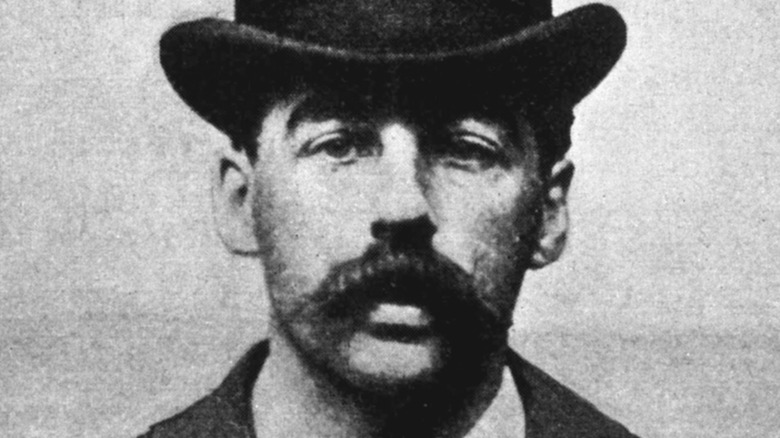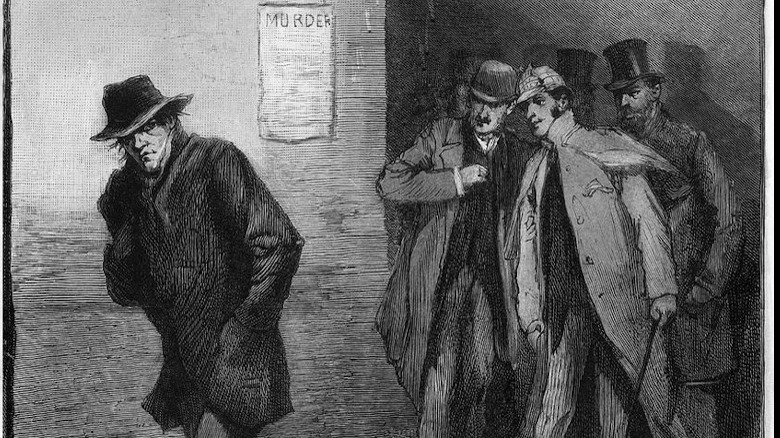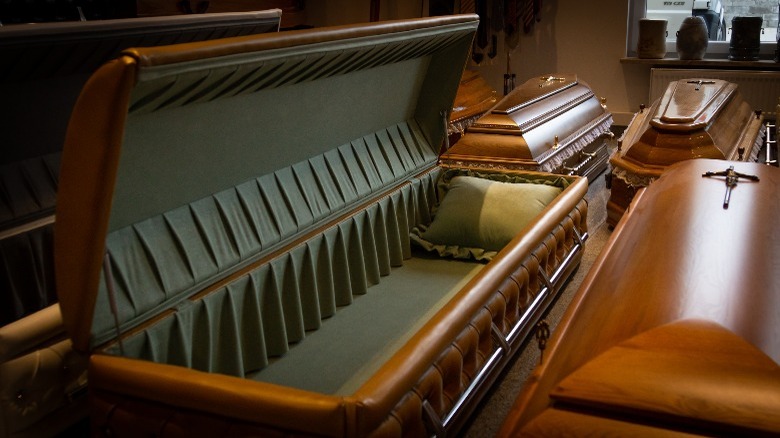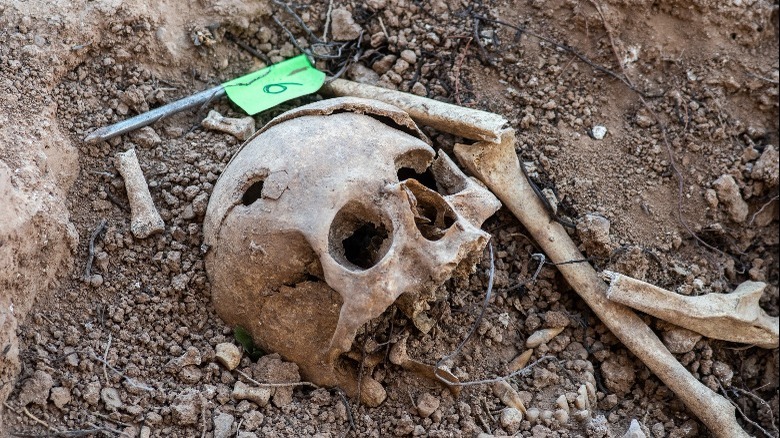The Unexpected Findings In Serial Killer H.H. Holmes' Gravesite
H.H. Holmes was one of the most notorious serial killers in American history — and possibly the first. The 2003 book "The Devil in the White City" by Erik Larson renewed interest in his crimes. Holmes — real name Herman Mudgett — has living descendants who came to believe there was more to his story.
What we know for sure: Mudgett was born around 1861 in New Hampshire and went to medical school at the University of Michigan. He moved to Chicago in 1886 where he famously built a hotel, now known as the "murder castle," that contained secret passages, trapdoors, soundproof rooms, gas jets, and a cremation kiln. These strange features helped him kill unsuspecting guests (via Britannica).
He was particularly active during the World's Columbian Exposition in 1893. Often, he killed for financial gain. He would become the life insurance beneficiary of his victims — employees or women he seduced — then murder them and collect the insurance. He sometimes sold the bodies to medical schools.
According to Britannica, he teamed up with a man named Ben Pitezel in 1894, and they traveled around the country committing fraud. He eventually murdered Pitezel and three of Pitezel's children. He was arrested after another criminal partner reported him for fraud. Historical records say he was then tried and hanged for the murder of Pitezel, but Mudgett's descendants weren't so sure that really happened. They also thought he might have committed murders on both sides of the Atlantic (via Philly Voice).
The London murders theory
Herman Mudgett's great-great-grandson Jeff Mudgett, a lawyer, didn't know about his ancestor's crimes until he was 40. He then dove into research and became convinced that Herman Mudgett was more than just the Chicago "devil" — Mudgett believed he was also Jack the Ripper.
Jack the Ripper, who was never caught, murdered and mutilated at least five women, all prostitutes, in London's East End in 1888. In his TED Talk on the subject, Jeff Mudgett points out that Herman Mudgett's whereabouts between July 1888 and January 1889 are unknown. This fits the window of Jack the Ripper's murders exactly. According to Historic Mysteries, an H. Holmes did travel from London to the U.S. shortly after those murders.
In his TED Talk, Jeff Mudgett presented "evidence" that the two were one and the same. Herman Mudgett matched the contemporary description and drawings of Jack the Ripper based on eyewitness accounts. Some pathologists who examined Jack the Ripper's victims thought he must have been a doctor with anatomical knowledge, which Herman Mudgett was. A letter from Herman Mudgett to his lawyer in the 1890s expressed a desire to be in London. His handwriting also seems to match that of the "Dear Boss" letter supposedly written by Jack the Ripper.
Jeff Mudgett published a book called "Bloodstains" about this theory, but many experts remain unconvinced.
The empty coffin
According to Philly Voice, Herman Mudgett was believed to have been hanged at Moyamensing Prison in South Philadelphia on May 7, 1896. NBC Chicago notes, however, that some newspapers at the time believed he had committed one last fraud: escaping his execution. In particular, an 1898 story from the Chicago Inter-Ocean quoted an alleged witness who said Mudgett bribed prison officials to substitute a cadaver for his body. The witness claimed Mudgett was smuggled out of the prison alive in his own coffin, then escaped to Paraguay and became a coffee farmer.
Jeff Mudgett became convinced that this was true and presented enough evidence to Philadelphia courts that they allowed the exhumation of Herman Mudgett, to prove the body in his grave was really his.
Jeff Mudgett teamed up with the History Channel, and they contacted archaeologists from the University of Pennsylvania's Museum of Archaeology and Anthropology, Dr. Janet Monge and Dr. Samantha Cox, who then led the exhumation (via Philly Voice).
The project commenced in the spring of 2017. They had a short time in which to complete the project, but the initial excavation of Herman Mudgett's grave revealed something unexpected: an empty wooden coffin six feet down. This didn't match cemetery records of his burial, which showed the coffin was 10 feet underground and encased in concrete, per Herman Mudgett's dying request (via Philly Voice). Did this mean he really had escaped?
A postmortum murder?
The empty coffin wasn't the only problem the team encountered, according to Philly Voice. Before they even started digging, they were informed that Herman Mudgett had tuberculosis (TB) before he died. The World Health Organization calls TB the most deadly infectious disease, and it can remain alive for decades. The archaeologists became worried that Mudgett might be able to kill from beyond the grave, via TB. They consulted experts who said the bacteria might very well still be alive and infectious in Mudgett's grave. The archaeologists decided everyone at the gravesite would have to wear filtration masks and gloves, and that a limited number of people would be allowed to handle the remains.
Fortunately, their fears were unfounded. No one on the project was infected.
The archaeologists decided to continue digging, despite the empty coffin, which they thought might be a decoy to deter potential grave robbers. They were afraid, however, that the body might have been moved. Using sounding probes, they determined that there was another object underneath the coffin. Four feet farther down, they found a concrete container with another coffin inside. It took them 12 hours to open the coffin and pump out the groundwater spilling into the grave, but once they had, they found a body, buried with a cross that said: "H.H. Holmes. Died May 7, 1896" (via Philly Voice).
Identifying the body
The body within the coffin had Mudgett's signature mustache, though it began to disintegrate when exposed to the air. The body wore boots, a vest, and a suit coat, but no pants, possibly indicating he experienced incontinence during his hanging. The brain was intact, which Samantha Cox said is common (via Philly Voice).
The team wanted to use DNA testing to determine the body's identity, but this is difficult with older DNA. They bored into the body's skull to extract DNA, which they sent to a lab at King's College in England, along with DNA from the Mudgett family.
Meanwhile, they tried to evaluate the body in other ways. They sent the skull to a dental school to be x-rayed; the skull's missing molars matched contemporary medical reports on Mudgett. Those reports proved especially helpful to the team, according to Philly Voice. Cox and Janet Monge explained that Victorian doctors tried to determine why people were "anti-social" or "psychotic" based on physical characteristics, a practice called phrenology. Therefore, they had carefully studied Mudgett, recording that he had short legs and long arms, one of which was longer than the other, and lumps on his skull.
The body in the tomb matched most of the records on Mudgett, except in height. Mudgett was recorded as being 5'8"; the body in the tomb was three to five inches shorter. The archaeologists speculated Mudgett might have worn lifts in his shoes (via Philly Voice).
The DNA Results
When the DNA results came back from England, they were "inconclusive," according to Philly Voice, however, further testing determined that the body in the tomb was a relative of the Mudgett family. The scientists on the project were thus convinced it was Herman Mudgett. He hadn't escaped execution.
The team hoped to do more tests on the body, but the Philadelphia courts and the Catholic archdiocese that owned the cemetery containing the grave both insisted Mudgett be reburied. After he was exhumed on May 6, 2017, he was reburied on Aug. 31, 2017.
Contrary to what Victorian doctors believed, Janet Monge said that nothing about Mudgett's body explained why he had committed such horrible crimes. During his lifetime, he almost certainly murdered nine people, but he confessed to 27 total murders and eventually claimed more (via Philly Voice). According to Britannica, some researchers believe he had more than 200 victims.
Whatever the case, Herman Mudgett, alias H.H. Holmes, continues to fascinate. Hulu is currently making a series based on "The Devil in the White City," produced by Martin Scorsese and Leonardo DiCaprio, with Keanu Reeves playing Daniel Burnham, architect of the World's Columbian Exposition (via IndieWire).





